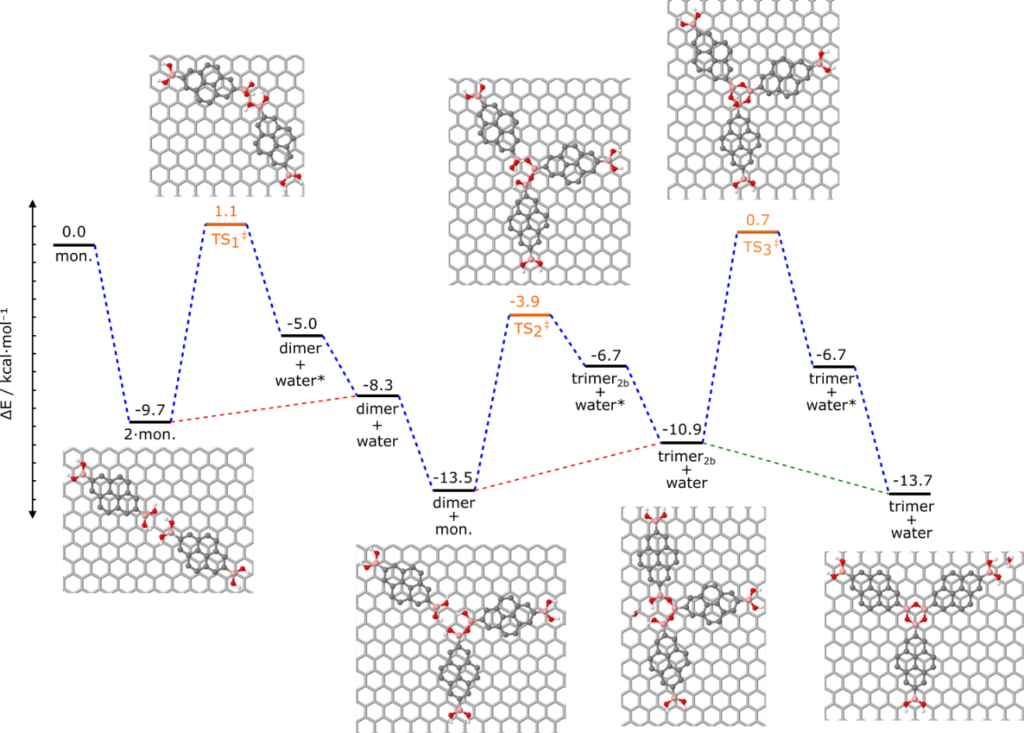Manuel Melle Franco, CICECO – Aveiro Institute of Materials (University of Aveiro)
We can no longer imagine life without polymers. Products made of polymers are all around us, ranging from clothing made from synthetic fibres to plastic lenses in glasses. Polymers are formed when small molecules called monomers are linked together to form long chains. If a monomer reacts concurrently with more than two other monomers, sheets with a periodic internal structure, called two-dimensional (2D) polymers, can be formed. Some of these 2D polymers are porous and may be used as membranes while other types are promising for advanced electronics applications. However, how these 2D polymers are exactly formed has remained so far elusive. The knowledge of their formation mechanism is fundamental in order to boost the size and structural quality of these interesting materials.
A team from KU Leuven (Belgium), POLYMAT and the University of the Basque Country (Spain), supported by computer models by the University of Aveiro (Portugal) have joined forces to provide an unprecedented insight into the mechanistic and kinetic aspects of the reactions leading to the formation of 2D polymers. Experimentally, they used scanning tunnelling microscopy, an advanced type of non-optical microscopy, able to follow in real-time, as bonds form and break, molecule by molecule, the birth and growth of these 2D polymers on a solid support immersed in a reactive solution. This was extensively complemented by computer models which were fundamental to support and rationalize the findings. It was found that several growth mechanisms co-exist and controlling them leads to the formation of high-quality large-size polymer sheets.
For this, the behaviour of the 2D material on the surface at different stages of polymerization was studied in-silico in high-detail. The models used were specially challenging as several systems from hundred to thousands of atoms had to be computed with accurate quantum Hamiltonians.

Calculations were performed in the Navigator Cluster – Laboratório de Computação Avançada (LCA) at The University of Coimbra and were funded within the “New Graphene Materials for Electronics, GraphEle” advanced computing project (CPCA/A2/2524/2020). The use of Navigator was fundamental as quantum calculations with nearly 16K atoms had to be performed in order to reveal the subtle incomensuration between the 2D polymer and the supporting surface.

For more information, see G Zhan et al. Nature 2022, DOI: 10.1038/s41586-022-04409-6.
Short CV
Manuel Melle Franco has a degree in Physical-Chemistry from the University of Santiago de Compostela (Spain, 1996) and an M.Sc. in Materials Chemistry (1997) and a PhD in Chemical Physics (2001), both from the University of Kent (UK). After that, he joined the group of Francesco Zerbetto in the Department of Chemistry of the University of Bologna (Italy,2000-2008) to later move to Portugal, where he worked as an independent researcher at the University of Porto and at the University of Minho (2008-2016). He currently works in CICECO – Aveiro Institute of Materials, at the University of Aveiro as a principal researcher. Manuel leads the Applied Computer Modelling Laboratory which uses models to understand complex experimental problems in several areas ranging from chemistry and physics to molecular biology, materials science and nanotechnology.
